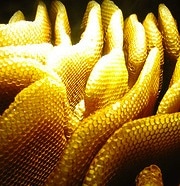
Beeswax is a natural ingredient that has several therapeutic properties. You can find it in skincare products such as lip balms, butters and lotions; centuries ago, before the development of paraffin candles, beeswax candles were commonplace too. Today, churches still use beeswax candles. If you are making your own natural skincare products, you might want to first understand a little bit about beeswax – and why it is added to cosmetic products.
Source of Beeswax
Beeswax is not extracted from a plant, unlike many other natural skincare ingredients; it is actually a natural product of the honey bee (genus Apis). Worker honeybees secrete a waxy substance to build the walls of the honeycomb. The beehive has to be at just the right temperature (91 to 97 degrees Fahrenheit) for the worker bees to be able to secrete the wax; the bees maintain the temperature within the hive by using water and flapping their wings in order to circulate air (source: The Chemistry of Bees).
The honeycomb is the home and workplace of the honeybee where both baby honeybees are raised and honey and pollen are stored. Beeswax is collected from the honeycomb by heating the honeycomb in water so that the wax separates from the water when it cools down (a similar process to the distillation of essential oils). It takes a lot of honey to produce a small quantity of beeswax; 10 pounds of honey yields just one pound of beeswax (source: Alabama Bee and Honey Producers).
Chemistry of Beeswax
Secreted beeswax is a white to colorless substance in liquid form; this turns into a yellow, tough, waxy solid substance on contact with the air. The color of solid beeswax may vary due to resins and plant material in the geographical area where the beeswax is produced. Beeswax can be softened by heat to work with for cosmetic product making. Beeswax is chemically composed of fatty acids, hydrocarbons and other minor components (source: What is Beeswax?).
Therapeutic Properties
Beeswax contains Vitamin A and has …










